Belgian born actress Ève Francis (1886-1980) was the star of the French impressionist cinema, in particular of the films by Germaine Dulac and Louis Delluc. Less known is that she was an active assistant director too.
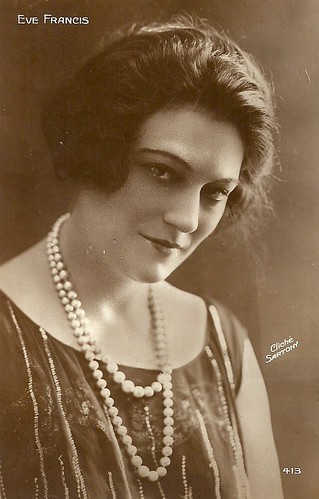
French postcard, no. 413. Photo: Sartony.
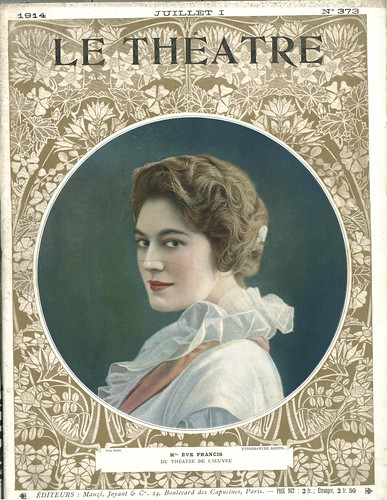
Cover of the magazine Le Théâtre, no. 373, 1914. Collection: Manuel Palomino Arjona (Flickr).
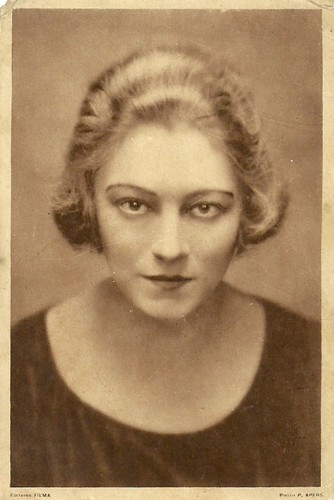
French postcard by Ed. Filma. Photo: P. Apers.
Ève Francis was born Eva Louise François in St. Josse-ten-Noode, Belgium in 1886. After completing her secondary education in Belgium, she embarked on a career as an actress and began working in the theatre in Paris in 1913.
The following year she was introduced to the author Paul Claudel who chose her for the leading role in the first Paris production of his play 'L'Otage' (The Hostage). Although only a few performances were given, the play was well-received in literary and artistic circles and established her reputation. She became Claudel's muse and interpreter, and in later years she described him as the most extraordinary person she had known and the dominant influence in her life. In 1914 she also made her film début in the silent short La dame blonde/The Blonde Lady (Charles Maudru, 1914) with Henry Roussel. Roussel next directed her in his film Un homme passa/A Man Passed (Henry Roussel, 1916).
In 1917 Francis played in Le roi de la mer/The King of the Sea (Jacques de Baroncelli, 1917), but she also appeared in her first film with female film director Germaine Dulac: Ames de fous/Fools' Hearts (1917). Dulac apparently liked Francis, as she gave Francis leading roles in Le bonheur des autres/The Happiness of Others (Germaine Dulac, 1918) and La fête espagnole/Spanish Fiesta (Germaine Dulac, 1920). Francis had one of her greatest successes in Marcel L'Herbier's El Dorado (1921) in which she played the ill-fated cabaret dancer Sibilla opposite Jaque Catelain. Francis became the epitomised actress of the French art film scene. She only played in the so-called Impressionist French silent films by Dulac, L'Herbier and later Louis Delluc.
Francis had met the young novelist, poet and playwright Delluc during the war. She had introduced him to the American cinema in 1916, and Delluc was smitten. He became an innovative film critic and later a prominent film director. They married in 1918. In the next five years, Delluc shot seven films, all with his wife. Two of these films remain among the immortal masterpieces of the French cinema: Fièvre/Fever (Louis Delluc, 1921) and La Femme de nulle part/The Woman from Nowhere (Louis Delluc, 1922). Gilles Delluc writes at Les Indépendants du premier siècle: "True films, shot in natural surroundings, without gesticulations and spectacular events. The characters are shown in an impressionistic way, intimist, often with a correlation between past and present, dream and reality. All this was a revolutionary for the time."
Louis Delluc's last film, L'Inondation/The Flood (1923) was shot in the Rhone Valley. The weather was cold and rainy, and Delluc developed a severe case of galloping consumption. He died at 33, in the span of a few weeks. After this tragedy, Francis returned to Dulac in 1924 for Ame’d’artiste/Heart of an Actress (Germaine Dulac, 1924) starring Ivan Petrovich and Nicolas Koline, followed by Antoinette Sabatier (Germaine Dulac, 1926).

Ivan Petrovich. French postcard by Cinémagazine-Edition, Paris, no. 581.
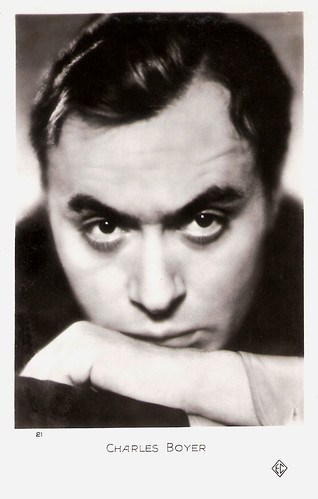
Charles Boyer. French postcard by EC (Editions Chantal), Paris, no. 21.
After her role in Antoinette Sabatier, Ève Francis did not appear in films for years. When she returned in the sound era, it was foremost as assistant director of Marcel L’Herbier. He had been another representative of the Impressionist cinema in the 1920s, but he was now working in a more conventional style.
Francis assisted Marcel L’Herbier with eleven films, including L’épervier/The Casting Net (1933) starring a young and very handsome Charles Boyer, Le scandale/The Scandal (1933) with Gaby Morlay, Le bonheur/Happiness (1934), La route impériale/The Imperial Road (1935) with Käthe von Nagy, Veille d’armes/Sacrifice of Honour (1935) with Annabella, La porte du large/The Great Temptation (1936) with Victor Francen, La citadelle du silence/The Citadel of Silence (1937) with Annabella, and La brigade sauvage/Savage Brigade (1939) with Charles Vanel.
Francis did also act in Club de femmes/Women's Club (Jacques Deval, 1936), Forfaiture/The Cheat (Marcel L'Herbier, 1937) with Sessue Hayakawa, La mode revée/The Ideal fashion (Marcel L'Herbier, 1939) with Gaby Morlay, La brigade sauvage/Savage Brigade (Marcel L'Herbier, 1939), La comédie du bonheur/Comedy of Happiness (Marcel L'Herbier, 1940), and the Italian version of the latter: Ecco la felicità/Here Comes Happiness (Marcel L'Herbier, 1940) both starring Michel Simon and Ramon Novarro.
In the postwar era, Francis supported the growing network of film societies in France (ciné-clubs), a project Louis Delluc first promulgated in 1920. She also did some television work in the late 1960s. She published two books, 'Temps héroïques: théâtre, cinéma' (Heroic Times: Theatre, Cinema, 1949), with a preface by Paul Claudel and her portrait of Louis Delluc. She recorded her recollections of Claudel himself in 'Un autre Claudel' (Another Claudel, 1973).
In her late eighties, she had two final film roles in La chair de l’orchidée/Flesh of the Orchid (Patrice Chéreau, 1974) starring Charlotte Rampling, and Adieu, poulet/The French Detective (Pierre Granier-Deferre, 1975) with Lino Ventura. Ève Francis died in 1980 in Neuilly-sur-Seine, France, at the age of 94.
Elements of the stage production of L'homme à la rose (1921) by Henry Bataille. Source: ben77114gaut (YouTube).
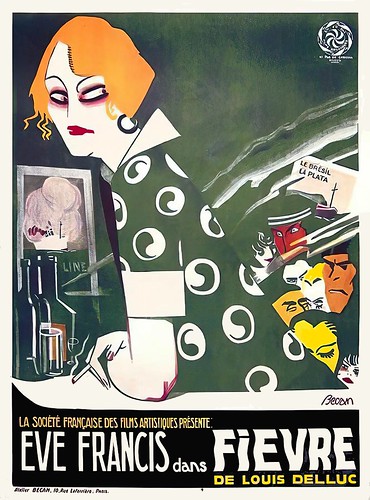
French affiche for Fièvre/Fever (Louis Delluc, 1921). Collection: Halloween HJB (Flickr).
Sources: Gilles Delluc (Les Indépendants du Premier Siècle), Daniel Chocron (CineArtistes.com - French), Wikipedia and IMDb.
This post was last updated on 10 April 2024.

French postcard, no. 413. Photo: Sartony.

Cover of the magazine Le Théâtre, no. 373, 1914. Collection: Manuel Palomino Arjona (Flickr).

French postcard by Ed. Filma. Photo: P. Apers.
Germaine Dulac and Louis Delluc
Ève Francis was born Eva Louise François in St. Josse-ten-Noode, Belgium in 1886. After completing her secondary education in Belgium, she embarked on a career as an actress and began working in the theatre in Paris in 1913.
The following year she was introduced to the author Paul Claudel who chose her for the leading role in the first Paris production of his play 'L'Otage' (The Hostage). Although only a few performances were given, the play was well-received in literary and artistic circles and established her reputation. She became Claudel's muse and interpreter, and in later years she described him as the most extraordinary person she had known and the dominant influence in her life. In 1914 she also made her film début in the silent short La dame blonde/The Blonde Lady (Charles Maudru, 1914) with Henry Roussel. Roussel next directed her in his film Un homme passa/A Man Passed (Henry Roussel, 1916).
In 1917 Francis played in Le roi de la mer/The King of the Sea (Jacques de Baroncelli, 1917), but she also appeared in her first film with female film director Germaine Dulac: Ames de fous/Fools' Hearts (1917). Dulac apparently liked Francis, as she gave Francis leading roles in Le bonheur des autres/The Happiness of Others (Germaine Dulac, 1918) and La fête espagnole/Spanish Fiesta (Germaine Dulac, 1920). Francis had one of her greatest successes in Marcel L'Herbier's El Dorado (1921) in which she played the ill-fated cabaret dancer Sibilla opposite Jaque Catelain. Francis became the epitomised actress of the French art film scene. She only played in the so-called Impressionist French silent films by Dulac, L'Herbier and later Louis Delluc.
Francis had met the young novelist, poet and playwright Delluc during the war. She had introduced him to the American cinema in 1916, and Delluc was smitten. He became an innovative film critic and later a prominent film director. They married in 1918. In the next five years, Delluc shot seven films, all with his wife. Two of these films remain among the immortal masterpieces of the French cinema: Fièvre/Fever (Louis Delluc, 1921) and La Femme de nulle part/The Woman from Nowhere (Louis Delluc, 1922). Gilles Delluc writes at Les Indépendants du premier siècle: "True films, shot in natural surroundings, without gesticulations and spectacular events. The characters are shown in an impressionistic way, intimist, often with a correlation between past and present, dream and reality. All this was a revolutionary for the time."
Louis Delluc's last film, L'Inondation/The Flood (1923) was shot in the Rhone Valley. The weather was cold and rainy, and Delluc developed a severe case of galloping consumption. He died at 33, in the span of a few weeks. After this tragedy, Francis returned to Dulac in 1924 for Ame’d’artiste/Heart of an Actress (Germaine Dulac, 1924) starring Ivan Petrovich and Nicolas Koline, followed by Antoinette Sabatier (Germaine Dulac, 1926).

Ivan Petrovich. French postcard by Cinémagazine-Edition, Paris, no. 581.

Charles Boyer. French postcard by EC (Editions Chantal), Paris, no. 21.
Marcel L'Herbier and Paul Claudel
After her role in Antoinette Sabatier, Ève Francis did not appear in films for years. When she returned in the sound era, it was foremost as assistant director of Marcel L’Herbier. He had been another representative of the Impressionist cinema in the 1920s, but he was now working in a more conventional style.
Francis assisted Marcel L’Herbier with eleven films, including L’épervier/The Casting Net (1933) starring a young and very handsome Charles Boyer, Le scandale/The Scandal (1933) with Gaby Morlay, Le bonheur/Happiness (1934), La route impériale/The Imperial Road (1935) with Käthe von Nagy, Veille d’armes/Sacrifice of Honour (1935) with Annabella, La porte du large/The Great Temptation (1936) with Victor Francen, La citadelle du silence/The Citadel of Silence (1937) with Annabella, and La brigade sauvage/Savage Brigade (1939) with Charles Vanel.
Francis did also act in Club de femmes/Women's Club (Jacques Deval, 1936), Forfaiture/The Cheat (Marcel L'Herbier, 1937) with Sessue Hayakawa, La mode revée/The Ideal fashion (Marcel L'Herbier, 1939) with Gaby Morlay, La brigade sauvage/Savage Brigade (Marcel L'Herbier, 1939), La comédie du bonheur/Comedy of Happiness (Marcel L'Herbier, 1940), and the Italian version of the latter: Ecco la felicità/Here Comes Happiness (Marcel L'Herbier, 1940) both starring Michel Simon and Ramon Novarro.
In the postwar era, Francis supported the growing network of film societies in France (ciné-clubs), a project Louis Delluc first promulgated in 1920. She also did some television work in the late 1960s. She published two books, 'Temps héroïques: théâtre, cinéma' (Heroic Times: Theatre, Cinema, 1949), with a preface by Paul Claudel and her portrait of Louis Delluc. She recorded her recollections of Claudel himself in 'Un autre Claudel' (Another Claudel, 1973).
In her late eighties, she had two final film roles in La chair de l’orchidée/Flesh of the Orchid (Patrice Chéreau, 1974) starring Charlotte Rampling, and Adieu, poulet/The French Detective (Pierre Granier-Deferre, 1975) with Lino Ventura. Ève Francis died in 1980 in Neuilly-sur-Seine, France, at the age of 94.
Elements of the stage production of L'homme à la rose (1921) by Henry Bataille. Source: ben77114gaut (YouTube).

French affiche for Fièvre/Fever (Louis Delluc, 1921). Collection: Halloween HJB (Flickr).
Sources: Gilles Delluc (Les Indépendants du Premier Siècle), Daniel Chocron (CineArtistes.com - French), Wikipedia and IMDb.
This post was last updated on 10 April 2024.
No comments:
Post a Comment